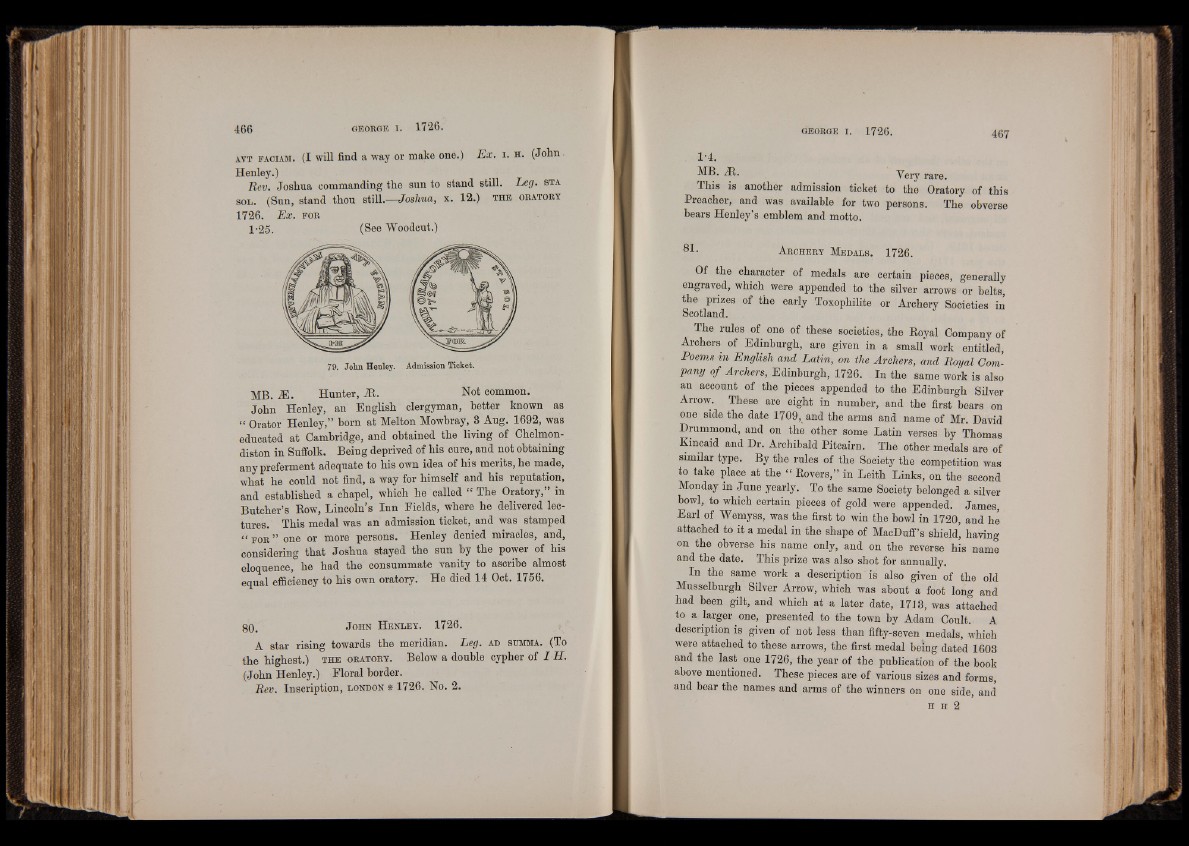
avt fa c iam . (I will find a way or make one.) Ex. i. h . (John
Henley.)
Rev. Joshua commanding the sun to stand still. Leg. sta
s o l . (Sun, stand thou still.—Joshua, x. 12.) t h e oratory
1726. Ex. fo r
1-25. (See Woodcut.)
79. John Henley. Admission Ticket.
MB. M . Hunter, At. Not common.
John Henley, an English clergyman, better known as
“ Orator Henley,” horn at Melton Mowbray, 8 Aug. 1692, was
educated at Cambridge, and obtained the living of Chelmon-
diston in Suffolk. Being deprived of his cure, and not obtaining
any preferment adequate to his own idea of his merits, he made,
what he could not find, a way for himself and his reputation,
and established a chapel, which he called “ The Oratory,” in
Butcher’s Row, Lincoln’s Inn Fields, where he delivered lectures.
This medal was an admission ticket, and was stamped
“ f o r ” one or more persons. Henley denied miracles, and,
considering that Joshua stayed the sun by the power of his
eloquence, he had the consummate vanity to ascribe almost
equal efficiency to his own oratory. He died 14 Oct. 1756.
80. J o h n H e n l e y . 1726.
A star rising towards the meridian. Leg. An summa. (To
the highest.) t h e o r a to r y . Below a double cypher of I ff.
(John Henley.) Floral border.
Rev. Inscription, London * 1726. No. 2.
1-4.
MB. Ht. "Very rare.
This is another admission ticket to the Oratory of this
Preacher, and was available for two persons. The obverse
bears Henley's emblem and motto.
8 1 • A r c h e r y M e d a l s . 1726.
Of the character of medals are certain pieces, generally
engraved, which were appended to the silver arrows or belts,
the prizes of the early Toxophilite or Archery Societies in
Scotland.
The rules of one of these societies, the Royal Company of
Archers of Edinburgh, are given in a small work entitled,
Poems in English and Latin, on the Archers, and Royal Company
of Archers, Edinburgh, 1726. In the same work is also
an account of the pieces appended to the Edinburgh Silver
Arrow. These are eight in number, and the first bears on
one side the date 1709, and the arms and name of Mr. David
Drummond, and on the other some Latin verses by Thomas
Kincaid and Dr. Archibald Pitcairn. The other medals are of
similar type. By the rules of the Society the competition was
to take place at the “ Rovers,” in Leith Links, on the second
Monday in June yearly. To the same Society belonged a silver
bowl, to which certain pieces of gold were appended. James,
Earl of Wemyss, was the first to win the bowl in 1720, and he
attached to it a medal in the shape of MacDuff’s shield, having
on the obverse his name only, and on the reverse his name
and the date. This prize was also shot for annually.
In the same work a description is also given of the old
Musselburgh Silver Arrow, which was about a foot long and
had been gilt, and which at a later date, 1713, was attached
to a larger one, presented to the town by Adam Coult. A
description is given of not less than fifty-seven medals, which
were attached to these arrows, the first medal being dated 1603
and the last one 1726, the year of the publication of the book
above mentioned. These pieces are of various sizes and forms,
and bear the names and arms of the winners on one side, and
h h 2